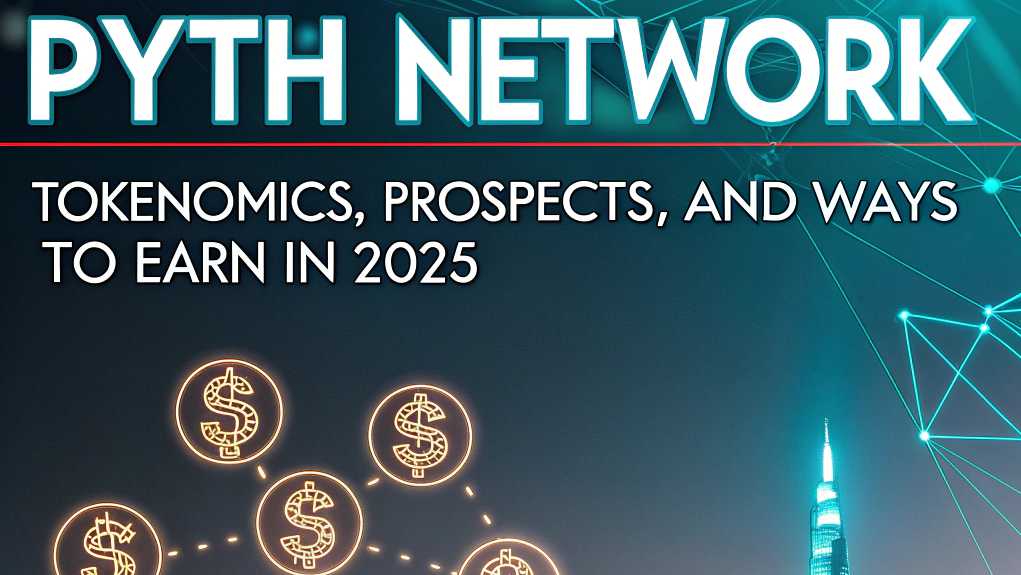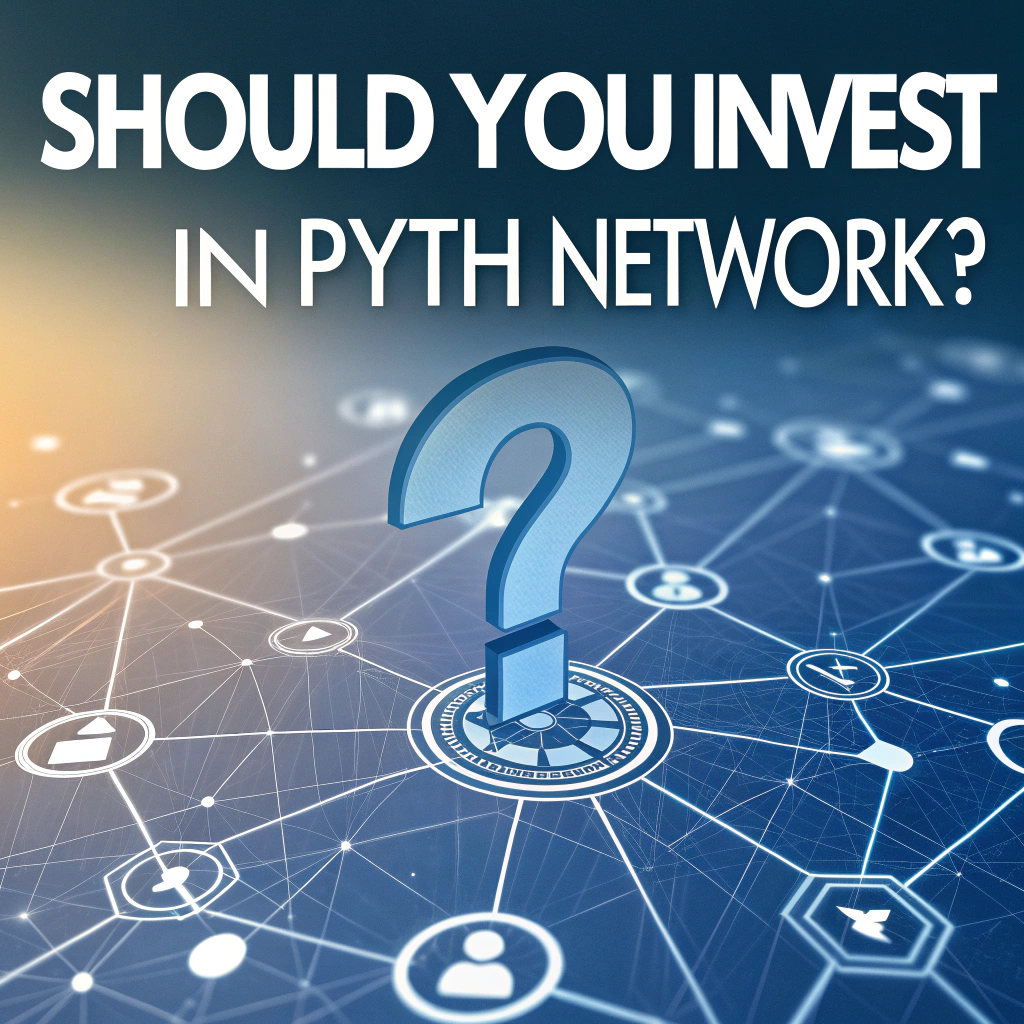Pyth Network: tokenomics, prospects, and ways to earn in 2025 — ASCN

Pyth Network: Tokenomics, Prospects, and Earning Opportunities in 2025 — ASCN
Anyone who has ever tried to understand DeFi eventually runs into the same question:
where do smart contracts actually get their data?
After all, blockchains are “blind” by nature — they can’t directly access real-world information. That’s exactly where one of the most promising technologies of 2025 steps in — Pyth Network.
But Pyth isn’t just another blockchain project. It’s an infrastructure layer that solves a fundamental problem for all of Web3. Let’s take a closer look.
What Is Pyth Network?
Pyth Network is a decentralized oracle network designed to deliver reliable, high-frequency financial data directly on-chain.
In simple terms, it provides smart contracts with accurate, real-time price feeds for assets such as cryptocurrencies, stocks, and commodities.

Project Overview
Launched on Solana in 2021, Pyth has rapidly evolved and, by 2025, become one of the key players in the oracle infrastructure market.
Unlike competitors such as Chainlink, Pyth doesn’t aggregate prices from random web APIs. Instead, it connects directly to primary sources — exchanges, market makers, and trading firms. This design dramatically improves data accuracy and minimizes latency.
It’s important to note that Pyth isn’t a standalone blockchain — it’s a network protocol that integrates with multiple blockchains (Ethereum, BNB Chain, Arbitrum, Avalanche, etc.), providing data wherever it’s needed.
Mission and Vision
The project’s mission is simple but ambitious:
to eliminate inaccuracy and latency in the delivery of market data across Web3.
In a DeFi and GameFi landscape where milliseconds and price precision can mean millions, Pyth aims to become the gold standard for oracle data.
The founders believe that reliable oracles are the foundation of decentralized finance — without them, no protocol can function properly. Everything from lending liquidations to derivative settlements to in-game asset pricing depends on them.
Who Needs Pyth Network and Why
The project targets several key user groups:
-
DeFi developers — who require fast, reliable price data for DEXs, lending platforms, and stablecoins.
-
Data providers — trading firms and exchanges that earn PYTH tokens by sharing accurate pricing data.
-
Investors and traders — who can participate through buying, staking, or governing the PYTH token.
-
Blockchain communities — that want to integrate high-quality oracles into their ecosystem.
By 2025, Pyth has integrated with dozens of blockchains and hundreds of protocols, from Solana to Ethereum L2s. Its tokenomics are designed so that every participant in the network has a financial incentive to keep it growing and secure.
How Pyth Network Works
Despite the complexity of oracles, Pyth’s core mechanism is relatively straightforward. The network follows a modular architecture — different participants perform specific roles: some supply data, others aggregate or validate it. This modularity provides both scalability and resilience.
Decentralized Data Oracles
Pyth’s main innovation lies in its next-generation oracle model.
Instead of simply relaying data from other APIs, Pyth’s contributors — such as centralized exchanges, market makers, and funds — act as primary data sources themselves.
Each data point they submit contributes to a consensus price, derived from aggregated inputs across the network.
The system uses a “pull-push” mechanism — data is published on demand, not on a fixed schedule. This reduces blockchain load and minimizes gas costs.
Data Providers and Validators
Today, Pyth counts over 90 verified data providers, including names like Jane Street, Cboe Global Markets, Wintermute, and Binance.
They earn PYTH tokens for submitting timely and accurate data.
Traditional validator roles are minimal in Pyth — consensus is handled algorithmically through aggregation and smart-contract logic.
Prices aren’t pushed directly onto every blockchain; instead, Pyth uses the Wormhole Messaging Layer — a cross-chain bridge that efficiently delivers aggregated data to multiple blockchains simultaneously.
Blockchain Integrations (Solana, Ethereum, and etc)
Between 2024 and 2025, Pyth aggressively expanded its multi-chain presence.
Its price feeds are now available across 50+ blockchains and L2 networks, including:
-
Solana — the project’s home network.
-
Ethereum and L2s such as Arbitrum, Optimism, and Base.
-
BNB Chain, Avalanche, Polygon, Aptos, Sui, and many more.
Cross-chain data delivery is powered by the Wormhole protocol, enabling instant and low-cost transfer of aggregated prices from Pyth’s mainnet to other chains.
This design gives developers flexibility — they can use Pyth’s oracles regardless of where their dApp is deployed.
PYTH Tokenomics: Distribution and Utility
The PYTH token is the backbone of the network — not just a speculative asset, but a key element of the ecosystem’s incentive and governance framework.
Core Functions of PYTH
1. Incentivizing data providers — contributors earn PYTH for submitting precise, real-time market data.
2. Governance and voting — token holders can propose and vote on protocol upgrades.
3. Access to data streams — developers can pay in PYTH for premium or high-frequency data feeds.
4. Staking and security — certain operations require staking PYTH, making potential attacks financially costly.
Token Distribution
The total supply of PYTH is 10 billion tokens.
85% of this amount was initially locked in smart contracts, set to be gradually unlocked over several years (6, 18, 40, and 42 months post-launch).
As of December 2023, 1.5 billion tokens (15%) were in circulation.
| Category | Available (%) | Locked (%) | Total (%) |
| Publisher Rewards | 0.5 | 21.5 | 22 |
| Ecosystem Development | 7 | 45 | 52 |
| Protocol Development | 1.5 | 8.5 | 10 |
| Community | 6 | 0 | 6 |
| Pre-sale | 0 | 10 | 10 |
| Total | 15 | 85 | 100 |
Incentive and Reward Mechanisms
Pyth’s design ensures a balanced incentive economy for all participants.
-
Data Rewards: providers (exchanges, market makers) are compensated in PYTH for each valid price update.
-
Loyalty Programs: active users interacting with Pyth-powered dApps receive additional rewards.
-
Developer Grants: teams building integrations or DeFi tools using Pyth can apply for grants.
-
Future Staking Model: an “economic security” concept is under discussion — requiring data providers to stake tokens as collateral, discouraging manipulation.
Additionally, the community pool funds airdrops and retroactive rewards to reward early contributors.
Governance and Voting
PYTH holders participate in on-chain governance, voting on protocol parameters, ecosystem grants, and data-source inclusion.
The model currently follows “1 token = 1 vote,” but delegated governance is being explored to improve participation and decentralization.
How to Earn with Pyth Network
By 2025, crypto investing goes far beyond simple token purchases.
Pyth Network offers several distinct ways to participate and earn — both active and passive.
Active Participation: Nodes and Data Providers
If you have access to reliable market data (for example, as an exchange or trading desk), you can become a data provider and earn PYTH tokens for publishing price updates.
Lightweight nodes and relayers are also being developed, enabling smaller players to contribute aggregated data to the network.
Airdrops
In 2023, Pyth conducted a major airdrop, distributing over 250 million tokens to active DeFi users who interacted with Pyth-powered protocols.
In 2025, community rumors point to a possible second wave — potential eligibility may include:
-
Activity in Pyth-integrated DeFi apps (e.g., Jupiter, Drift, Mango)
-
On-chain governance participation
-
Developers testing or deploying dApps with Pyth integration
Although unconfirmed, the ecosystem fund has allocated resources for future distributions — so it’s worth monitoring Pyth’s official Twitter for updates.
Trading the PYTH Token
PYTH is listed on major centralized exchanges and on Jupiter (Solana) for decentralized trading.
The token shows healthy volatility, making it attractive for short-term trading — but note that scheduled unlocks can put pressure on price.
Grants and Loyalty Programs
Pyth actively funds ecosystem development through several initiatives:
-
Pyth Grant Program — financial support for teams building on Pyth.
-
Ambassador Program — incentives for community growth and social outreach.
-
Developer Rewards — payouts for code contributions and technical improvements.
In 2024, one analytics team received a $50,000 grant for developing a real-time Solana dashboard visualizing Pyth’s data feeds.
For Web3 developers, these programs are both profitable and reputationally valuable.
Strengths and Weaknesses of Pyth Network
When people think about decentralized oracles, Chainlink usually comes to mind first.
But since 2023, a strong competitor has emerged — Pyth Network.
By 2025, Pyth has grown from a newcomer into a serious DeFi infrastructure player, with a distinct model and expanding ecosystem.
Still, like any project, it has both advantages and challenges.
Comparison: Pyth vs Chainlink
| Criteria | Chainlink | Pyth Network |
| Data Sources | Aggregated from web APIs | Direct feeds from exchanges & market makers |
| Update Frequency | Scheduled, often every minute | Event-based, near real time |
| Blockchain Support | Ethereum, BNB, Avalanche, etc. | Solana + 50+ chains via Wormhole |
| Incentives | Staking, payment for feeds | Rewards for updates, planned staking |
| Token Economy | Mature and stable | Actively evolving in 2025 |
The key distinction is that Pyth sources data directly from originators, while Chainlink relies on middle-layer aggregators.
This makes Pyth theoretically faster and more precise — especially for high-frequency trading or derivatives.
However, Chainlink’s longer history (since 2017) and larger trust base make it the default oracle choice for many protocols.
Scalability and Speed
Pyth’s architecture is built for high-frequency, low-latency data delivery — perfect for use cases like automated liquidations, on-chain derivatives, and real-time trading systems.
Because updates occur only when requested, the network avoids congestion and reduces gas costs.
Additionally, the Wormhole bridge allows the same price feed to be distributed across dozens of blockchains simultaneously, a major advantage for multichain DeFi ecosystems.
Potential Risks
Even with its technological strengths, Pyth faces some notable risks:
-
Centralized data sources: most providers are still large, centralized institutions — this introduces potential bias or conflicts of interest.
-
Token volatility: PYTH remains a young asset with frequent unlocks that can pressure the price.
-
Validator concentration: a limited set of participants may handle critical aggregation logic.
-
Liquidity gaps: some DEX pairs have relatively low trading volumes.
-
Limited GameFi presence: Pyth is heavily focused on financial data, with less penetration in gaming or NFT oracles.
Each of these factors could influence investor confidence or short-term token performance.
Future Outlook: 2025–2027
Now for the key question — what’s next for Pyth Network?
Partnership Expansion
Partnerships remain Pyth’s biggest growth driver.
By 2025, the project already counts 400+ integrations with DeFi protocols.
Plans for 2026–2027 include:
-
Expanding its footprint across Ethereum’s zk-rollups (zkSync, Linea, Scroll).
-
Partnering with GameFi and NFT platforms such as Metaplex and Fractal.
-
Strengthening ties with centralized exchanges and financial institutions to supply tokenized asset data.
Cross-Chain Expansion
By 2025, Pyth operates across more than 50 chains.
By 2027, it aims to support all EVM-compatible L2s, integrate with Polkadot, and release a universal SDK that lets developers embed Pyth into any blockchain environment.
This will naturally increase demand for the PYTH token as a utility asset, as more dApps will rely on its data feeds.
PYTH Price Outlook
As of mid-2025, the PYTH token trades between $0.09 and $0.12, with a market cap around $650 million.
Bullish Scenario (2026):
If Pyth achieves broad DeFi adoption, launches staking, and successfully enters the zk-rollup market, analysts project a price range of $0.40–$0.55, corresponding to a market cap of $2–2.5 billion.
Bearish Scenario:
If governance stalls or Wormhole suffers technical vulnerabilities, PYTH could correct to $0.06–$0.08.
Long-Term Growth Potential
Should the team successfully implement staking, reward automation, and broaden cross-chain support while maintaining bridge security,
Pyth could realistically become the next-generation oracle standard for Web3.
Its direct data sourcing and low-cost architecture give it a competitive edge over Chainlink in the long run — provided it scales responsibly.
Should You Invest in Pyth Network?
Pyth Network is one of those rare crypto projects where the buzz actually hides real infrastructure value.
But is it worth investing in PYTH right now — and for whom does it make sense?

Who Pyth Is Best For
-
Infrastructure-oriented investors — looking for foundational Web3 projects.
-
Developers and builders — those creating dApps can earn both tokens and community support.
-
Governance participants — active holders influencing the protocol’s direction.
-
Short-term traders — taking advantage of volatility and unlock cycles.
For beginners seeking “pump” coins without understanding the fundamentals, Pyth may feel too complex.
A basic grasp of blockchain infrastructure is essential here.
What to Consider Before Buying PYTH
Before investing, analyze the following:
-
Token unlock schedule — unlocks continue through 2027, which may pressure price.
-
Network usage — demand for PYTH depends directly on the network’s adoption.
-
Liquidity — strong on CEXs, but weaker on some DEX pairs.
-
News and governance decisions — can trigger sharp market reactions.
-
Wormhole security — as the key bridge for Pyth, any exploit could affect the entire ecosystem.
Long-Term or Speculative Asset
That depends on your strategy:
-
Long-term (HODL) investors:
If you believe in the growth of DeFi infrastructure, Pyth represents a logical bet.
A 3–4x appreciation by 2026–2027 is plausible under positive execution. -
Short-term traders:
PYTH’s volatility and unlock phases provide trading opportunities — but it requires active monitoring of whale movements and governance events. -
Developers and contributors:
For those building on Pyth, it’s more than an investment — it’s a gateway to professional growth in the Web3 data economy.
Final Thoughts
Pyth Network isn’t your typical token.
It’s a data infrastructure protocol bridging the gap between traditional markets and blockchain systems — competing head-to-head with giants like Chainlink.
The project combines technological sophistication with strong fundamentals, giving it everything needed to become a new oracle benchmark.
Still, like any innovation, its path forward comes with both opportunities and risks.
And while exploring such complex ecosystems can be challenging, you don’t have to do it alone.
That’s where ASCN.ai comes in — an intelligent crypto assistant built to simplify deep analysis, risk assessment, and yield tracking across the blockchain landscape.
Whether you’re a beginner or a professional trader, ASCN.ai helps you evaluate projects, uncover airdrops, and monitor staking opportunities with precision.
It’s not just another chatbot — it’s your strategic partner in navigating the evolving world of Web3.

